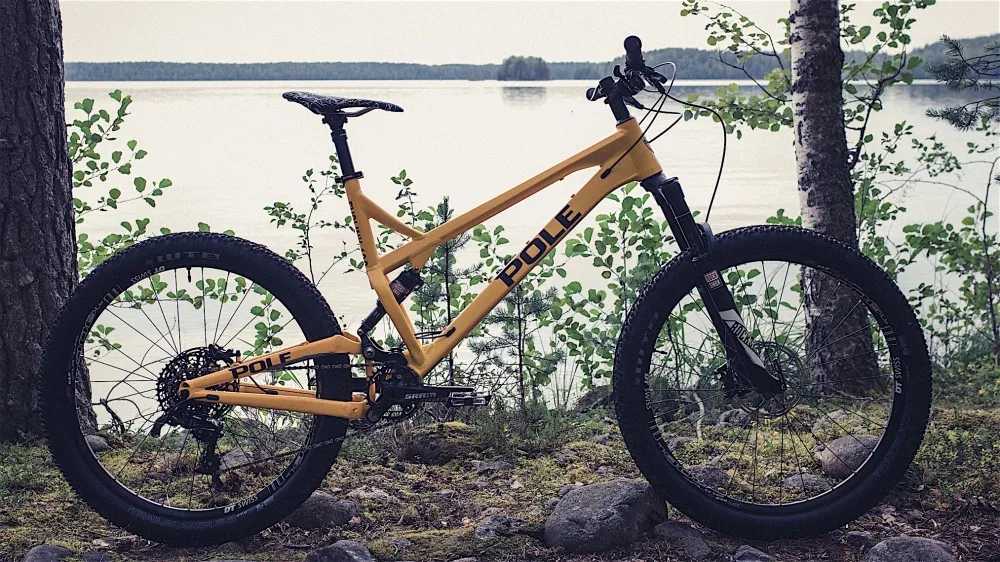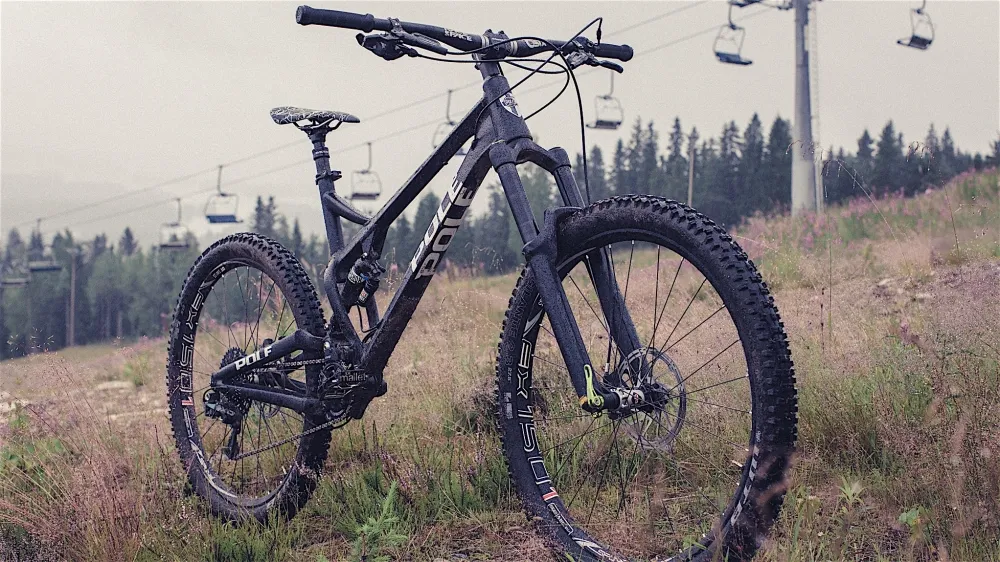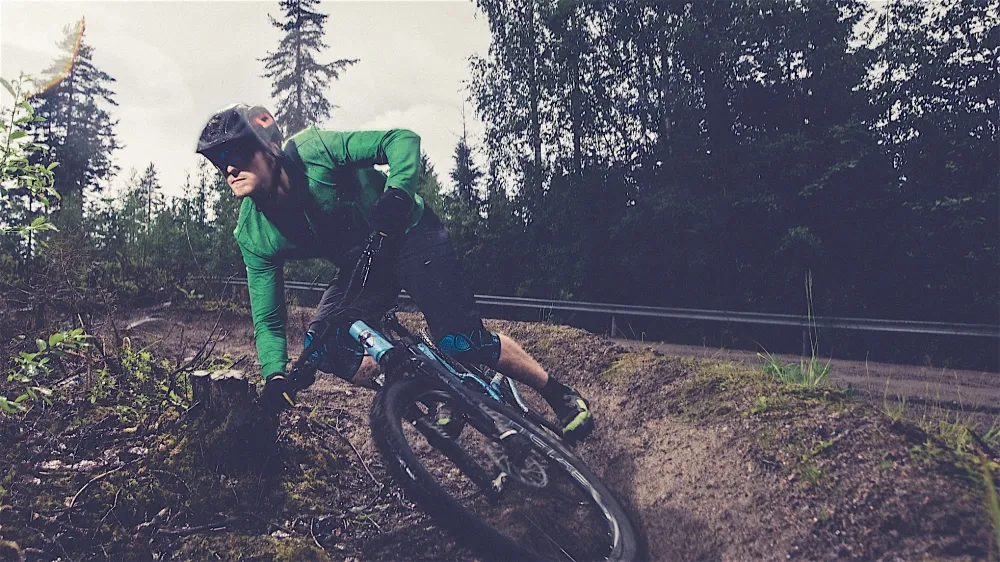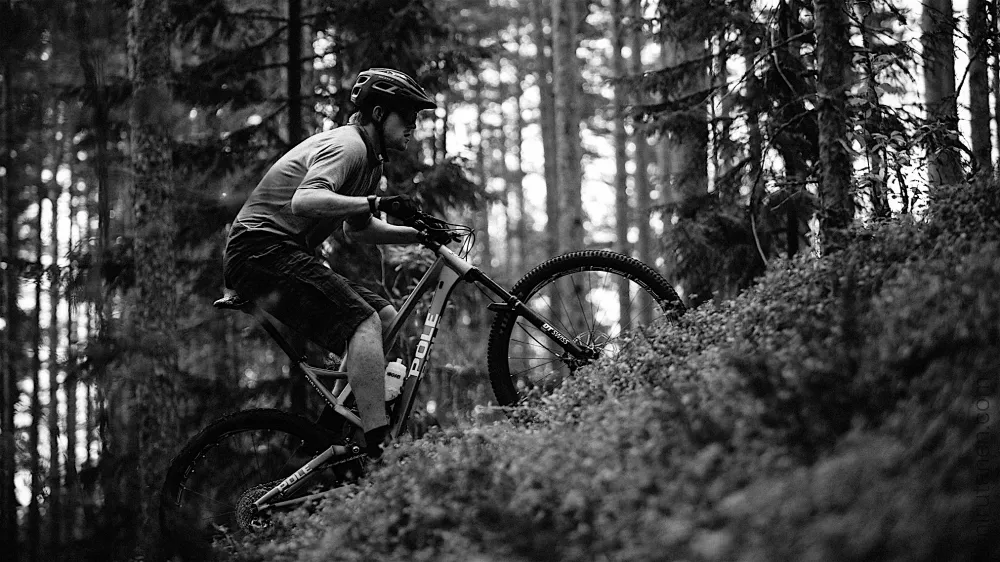Last December, I received a bike from a little-known Finnish company that would change how I thought about mountain bike geometry. That bike was the Pole Evolink 140, and over the next few months I grew to love how its radical shape allowed me to ride. This summer, I travelled to Finland, to meet Pole’s founder, Leo Kokkonen, and ride the other four bikes which make up the company’s radical range.
- The Pole Evolink 140 is the longest bike you've never heard of
- Mojo/Nicolai extra-Longest Geometron first ride review
- How long can you go? Jon Woodhouse's extreme geometry hardtail - video
Pole’s five full-sus bikes cover everything from XC to DH, yet share a lot of common features. Massive wheelbases, slack head angles, steep seat angles and an unusual suspension design characterise Pole’s distinctive ride.
We’ve ridden all five in the rocky, unforgiving and downright weird terrain that makes up their proving grounds in Finland. Expect full reviews of the individual bikes in due course, but for now, take a look at the key stats for each bike:

Evolink 110
- Travel: 110/120mm
- Wheel size: 29”
- Head angle: 66°
- Wheelbase: 1,308mm (XL)
- Weight: 12.1Kg (XL)

Evolink 130
- Travel: 130/140mm
- Wheel size: 27.5+
- Head angle: 65°
- Wheelbase: 1,310mm
- Weight: 14.5Kg

Evolink 140
- Travel: 140/150mm
- Wheel size: 29”
- Head angle: 64.5°
- Wheelbase: 1,315mm (L)
- Weight: 14.4Kg

Evolink 150
- Travel: 150/160mm
- Wheel size: 27.5”
- Head angle: 63.5°
- Wheelbase: 1,320mm (L)
- Weight: 14.8Kg

Evolink 176
- Travel: 176/200mm
- Wheel size: 27.5”
- Head angle: 62°
- Wheelbase: 1,355mm (L)
- Weight: 16.7Kg
Pole's bike characteristics
All of these bikes share five unusual characteristics. Here we’ll try and find out why Pole has made such unconventional choices on each front.
1. Slack head angles, and not just for downhill
We’re used to seeing slack head angles on DH bikes. The pursuit of riding at speed over steep and rough terrain makes them a no-brainer; most DH bikes have coalesced around 63 degrees. Pole’s DH bike stands slightly slacker at 62 degrees, but shorter rear travel than front means the dynamic head angle (when sagged) is about the same as its peers — so far, so normal.
With the right technique, though, slack head angles add clarity and control through rough terrain
It’s the rest of Pole’s fleet that breaks the mold. From the 63.5° Evolink 150 Enduro bike to the 110 at 66° — surely the slackest XC 29er on the market, and by some margin. Does that make it climb like a barge? Well no, actually.
Slack head angles are associated with bikes that climb terribly, but the combination of a long, comfortable reach and steep seat angle take care of the wandering front wheel: the head angle actually has very little to do with it.
There are drawbacks, of course. Slack bikes feel lazier in sudden tight turns, and can take more effort to change line, especially once leant into a corner. It also takes more effort to weight a front wheel that’s raked-out in front of the handlebars, so a change in technique is required for anything other than ‘point-and-shoot’ terrain.
With the right technique, though, slack head angles add clarity and control through rough terrain; they boost confidence when tackling steep chutes and encourage fast, aggressive corner-carving.

2. Long reach and short stems
Mondraker led the way in this area with their Forward Geometry concept back in 2014, offering improved comfort and confidence when tackling steep and technical terrain.
Since then many other companies have crept forward in the direction of long frames and short stems, but Pole has embraced it fully, with similar or longer reach figures comparable to Forward Geometry bikes from Mondraker. Pole’s use of slacker head angles and longer chainstays boost the stability (and wheelbase) even further.

3. Steep seat angles
Every full-sus Pole has an effective seat angle of 77.5°. That’s steeper than almost any other bike on the market, with the notable exception of Mojo and Nicolai’s GeoMetron, which has the same seat angle. It’s not necessarily ideal for cruising along on the flat, but if you’re using the saddle on a mountain bike you’re usually going uphill.
When climbing, the rear suspension squats down while the fork lifts up. The steep seat angle compensates for this, providing a more neutral position for the uphill slogs. This takes strain off of the arms and hamstrings while preventing the front wheel from lifting.
Such steep seat angles combined with short stems would make the bike feel too cramped if it was not for the extra-long reach figures; which open up the arms, expanding the lungs when climbing. Meanwhile, the slack head angle deals with rocky uphill terrain that would otherwise have you feeling like you were pitching too far forward with such a steep seat angle. The two actually work together.

4. Unfashionably long chainstays
Short chainstays are the current buzzword in MTB design. Yes, they do make a bike easier to manual, and they help to offset some of the inevitable increase in wheelbase resulting in longer and slacker geometry. However, when I’ve tested bikes with adjustable chainstay lengths (Scott Gambler, Canyon Sender, Mondraker Dune), I’ve always been sure to back-to-back test both chainstay lengths on the same track.
In each case, I found the longer version feels more stable, calm, and more predictable in the corners, especially when drifting.
By moving the rear contact patch further behind the rider, the bike is less perturbed by rough and loose terrain. It also complements the longer front centre by shifting the weight balance towards the front wheel slightly, making it easier and safer to corner hard.
It’s worth mentioning that as a taller rider, I may stand to benefit from long chainstays more than most, and it may be a result of my height that I have no problem manualling any of Pole’s bikes. This is why Norco offers different chainstay lengths for each frame size. Still, it certainly isn’t the case that shorter chainstays are better for everyone, as some manufacturers might have you believe.

5. Suspension designed to minimise feedback, not bob
All suspension systems must strike a balance between efficiency and pedal kickback. It’s all to do with anti-squat — the extent to which the chain tension is used to resist the suspension’s movement (or bob) when pedalling.
More anti-squat means less bob and better pedalling efficiency. The downside is that the chain forces the cranks to rotate backwards on sudden compressions; this is known as pedal kickback, which can be off-putting and increases leg fatigue on long descents. Higher anti-squat also tends to reduce suspension sensitivity, as the chain has to move more in order to accommodate the suspension’s action; this is known as chain growth.
Pole’s early full-sus bikes used a single-pivot arrangement that rotated concentrically around the bottom bracket. This resulted in zero anti-squat: no pedal-kickback and a ‘chainless feeling’ through the rough, but poor pedalling efficiency.
Pole has since developed its Evolink suspension system, which offers more of a balance between pedalling efficiency and sensitivity. Cleverly, the amount of anti-squat decreases as the suspension moves through its travel; meaning less chain-growth deeper in the stroke, where it’s not needed to resist pedalling forces. This reduces kickback, while still providing a fairly efficient pedalling action near the sag point.
Anti-squat levels that decrease through the travel are not unique to Pole, but we think Pole has struck a particularly good balance. There is hardly any appreciable pedal kickback and the suspension tracks through fast hits nicely, yet the bikes pedal well enough that we rarely felt the need for lockout.

Three questions with Pole founder, Leo Kokkonen
Seb: Slack and long with steep seat angles — people will say you’ve just copied Chris Porter! What would you say to them? Did you collaborate at all?
Leo: I think that we were thinking about the same thing at the same time. Chris happens to be a more well-known person than me to get media attention. After Chris' story on Dirt we exchanged emails about suspension and transmission, which he also mentioned in the story. I think we both did our homework to get to similar figures on geometry. There are some differences in our thinking though: Chris doesn't seem to care about the 29" wheels, but I love them!
Seb: Could you explain briefly the process by which you arrived at the geometry you have now?
Leo: A few years ago I bought a bike that I wanted to use to enduro, but I did not feel that it was a safe bike to ride fast. I started to do experiments with a K9 DH frame which had a lot of options to play with. I collaborated with Tam Hamilton from BTR where we built the first steel protos. We had the head angles slack on the proto's already because it's just a no brainer for a DH rider.
With the steel protos I noticed that the seat tube angle is not ideal for up-hills and I started to experiment with a new radical angle by turning the seat post the wrong way around and bending the saddle rails to make it almost level. When the saddle was closer to the handlebars I needed to get the reach also longer. Then I noticed that when the reach is even longer the bike is easier to ride as well, but I needed to balance the rear centre as well.
Seb: Why did you decide to move on from your single-pivot ‘Polelink’ suspension system to the multi-link ‘Evolink’ design?
Leo: With the Polelink we had problems with production. We needed to change factory and we had to leave the jigs behind. I took this challenge as our advantage and designed a new system, which has anti-squat in the beginning of the stroke. People didn't seem to like the concentric design that much and I think that the new design was a good compromise between our old and new designs. Also I could design a progressive leverage curve to the bike with the short-links. With multiple links the rear is also stiffer.
Pole isn’t alone
Chris Porter of Mojo suspension has arrived at a remarkably similar geometry configuration with the GeoMetron. Slack and long with steep seat angles and short stems; both Pole and Mojo have come up a similar solution to the problem of riding fast, both uphill and down, and they’ve done it independently through their own testing.
Perhaps it’s a coincidence; perhaps it’s an example of simultaneous invention — when ideas are developed concurrently at a time when they are needed. A famous example would be the theory of evolution being developed by one Alfred Russel Wallace independently of Charles Darwin. Perhaps this ‘new-school geometry’ is just another example of an idea that's time has come. It certainly seems to work for us.
We’d like to thank Tahko resort and Laajavuori Bike Park for facilitating all the lift-assisted riding necessary to test five bikes in as many days, as well as Toni Rutanen for providing the photography.




